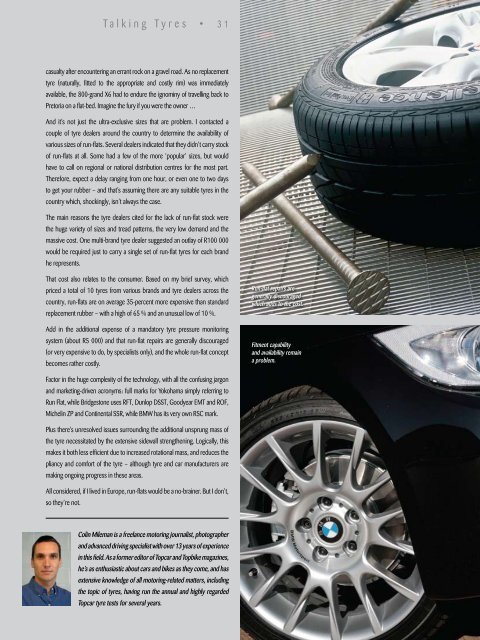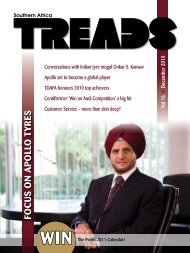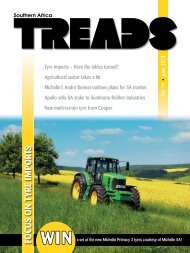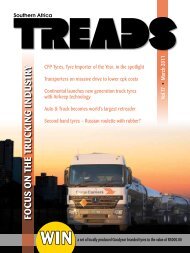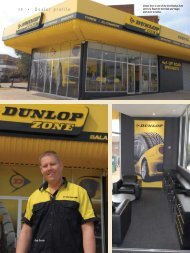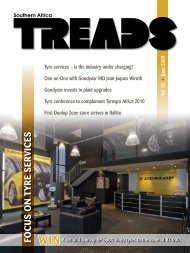Download - SA TREADS
Download - SA TREADS
Download - SA TREADS
Create successful ePaper yourself
Turn your PDF publications into a flip-book with our unique Google optimized e-Paper software.
Talking Tyres • 31<br />
casualty after encountering an errant rock on a gravel road. As no replacement<br />
tyre (naturally, fitted to the appropriate and costly rim) was immediately<br />
available, the 800-grand X6 had to endure the ignominy of travelling back to<br />
Pretoria on a flat-bed. Imagine the fury if you were the owner …<br />
And it’s not just the ultra-exclusive sizes that are problem. I contacted a<br />
couple of tyre dealers around the country to determine the availability of<br />
various sizes of run-flats. Several dealers indicated that they didn’t carry stock<br />
of run-flats at all. Some had a few of the more ‘popular’ sizes, but would<br />
have to call on regional or national distribution centres for the most part.<br />
Therefore, expect a delay ranging from one hour, or even one to two days<br />
to get your rubber – and that’s assuming there are any suitable tyres in the<br />
country which, shockingly, isn’t always the case.<br />
The main reasons the tyre dealers cited for the lack of run-flat stock were<br />
the huge variety of sizes and tread patterns, the very low demand and the<br />
massive cost. One multi-brand tyre dealer suggested an outlay of R100 000<br />
would be required just to carry a single set of run-flat tyres for each brand<br />
he represents.<br />
That cost also relates to the consumer. Based on my brief survey, which<br />
priced a total of 10 tyres from various brands and tyre dealers across the<br />
country, run-flats are on average 35-percent more expensive than standard<br />
replacement rubber – with a high of 65 % and an unusual low of 10 %.<br />
Add in the additional expense of a mandatory tyre pressure monitoring<br />
system (about R5 000) and that run-flat repairs are generally discouraged<br />
(or very expensive to do, by specialists only), and the whole run-flat concept<br />
becomes rather costly.<br />
Run-flat repairs are<br />
generally discouraged<br />
which adds to the cost.<br />
Fitment capability<br />
and availability remain<br />
a problem.<br />
Factor in the huge complexity of the technology, with all the confusing jargon<br />
and marketing-driven acronyms: full marks for Yokohama simply referring to<br />
Run Flat, while Bridgestone uses RFT, Dunlop DSST, Goodyear EMT and ROF,<br />
Michelin ZP and Continental SSR, while BMW has its very own RSC mark.<br />
Plus there’s unresolved issues surrounding the additional unsprung mass of<br />
the tyre necessitated by the extensive sidewall strengthening. Logically, this<br />
makes it both less efficient due to increased rotational mass, and reduces the<br />
pliancy and comfort of the tyre – although tyre and car manufacturers are<br />
making ongoing progress in these areas.<br />
All considered, if I lived in Europe, run-flats would be a no-brainer. But I don’t,<br />
so they’re not.<br />
Colin Mileman is a freelance motoring journalist, photographer<br />
and advanced driving specialist with over 13 years of experience<br />
in this field. As a former editor of Topcar and Topbike magazines,<br />
he’s as enthusiastic about cars and bikes as they come, and has<br />
extensive knowledge of all motoring-related matters, including<br />
the topic of tyres, having run the annual and highly regarded<br />
Topcar tyre tests for several years.


